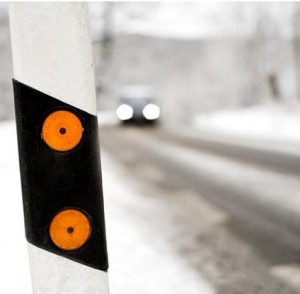Snow is beautiful until it falls on a workday. That’s when you and I realize we are the only ones who know how to drive on the slick stuff. To be fair, operating a car under low or no-friction conditions is not intuitive. As Bill Cosby said, “Turn into the skid? That’s like leaning into a left hook.”
So here are a few pointers for the rest of the drivers out there on the road:
- CLEAN YOUR VEHICLE. Before you pull out of your driveway, brush the snow off your vehicle, particularly the headlights, turn signals, and taillights, as well as the front, rear, and side windows.
- CHECK THE WIPER BLADES. Make sure they are not stuck to the windshield.
- MANUALLY TURN ON HEADLIGHTS before driving off. Depending on automatic daytime running lights may not turn on the rear parking lamps, so if visibility is poor the following car will have trouble seeing you. Now you can see and be seen.
- DO EVERYTHING SLOWLY.Accelerate slowly, steer slowly, and avoid abrupt corrections. Brake slowly and much sooner than you think necessary. Pretend there is a bowl bolted to your hood (humor me here), with a large Grade A raw egg inside. Your task is to keep the egg in the bowl and intact. Although entertaining, I don’t want to see you on the 5 o’clock news pinwheeling through a major intersection.
- PATIENCE IS NOT ONLY A VIRTUE, IT MAY SAVE YOUR LIFE. Allow more time to get where you are going. Leave more room between you and the vehicle ahead. So what if three cars pull in front of you, you’re making the world a safer place, at least for today.
- GIVE 18-WHEELERS EXTRA ROOM! Don’t take advantage of the 10 car lengths that the 18-wheeler has left in front of him. He needs that extra room as he frantically tries to slow down for the next light or traffic stoppage. He really needs all that room to stop, and if you zip in front of him, your egg will fly out of that bowl on your hood as he creams you from behind. Either that or his words may fry it.
- DON’T ASSUME. Just because the pavement is clear where you are now, it likely won’t still be clear 100 yards down the road or around the next corner. Snow melts and refreezes on shady or colder portions of pavement. Chemicals get diluted and allow treated surfaces to refreeze. Bridges are always colder, hence the warning signs about bridges surfaces freezing before pavement.
- DON’T USE CRUISE CONTROL. YOU must be in control. Some not-so-funny things can happen if you hit ice or snow with the cruise control engaged.
- ANTICIPATE THE OTHER GUY. Particularly as you approach intersections with stopped vehicles, slow down, take your foot off the gas, and be prepared to brake or take evasive maneuvers. Remember that the driver in front of you who is starting from a stop must overcome inertia without the benefit of normal traction. That driver’s ability to get out of your way is compromised. If you are the driver who is stopped or barely moving at the intersection, don’t create a situation: The car coming up fast on your left may travel 1/4 mile before you slip and slide your way across two lanes of highway in front of him.
- DON’T HAVE MISPLACED CONFIDENCE IN YOUR VEHICLE. Four-wheel and all-wheel drive vehicles are terrific and can take you off road, through an unplowed parking lot, or out of a snow drift better than most any car. But on snowy roads, these vehicles also can get you from zero to trouble faster than a student driver in a Corvette. We’ve all seen it, snow and slush flying off the tires while a four-wheeler rockets past, as if the laws of physics had been suspended just for them. Several miles down the highway, you then see the tracks leading through the median or off the shoulder. What happened? If you have a four-wheel vehicle, you will certainly have noticed that you can out-accelerate rear or front-wheel drive vehicle in slippery conditions, HOWEVER, once moving you have NO advantage! In fact, because of the high center of gravity and the extra weight, your four-wheel drive vehicle is likely to require more time to come to a full stop that a standard vehicle. Combine that with the increased propensity to roll over in single vehicle accidents, and I DRIVE SLOWER IN A FOUR-WHEELER.
- STAY HOME. My best advice, since you and I agree that the problem is everyone else.




